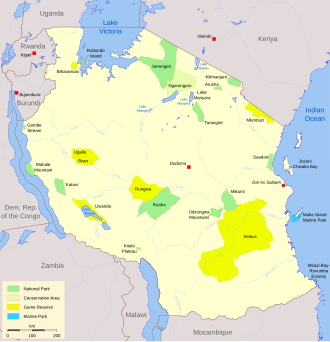Wikijunior:World Heritage Sites/Serengeti
Serengeti is a region of savannah (woodlands and grasslands) in East Africa. The south of it (80%) belongs to Tanzania. The north of it is in Kenya. The size of the region is about 30,000 square kilometers. It is also one of the greatest areas for wildlife. It has more than 1.6 million herbivores and thousands of predators (animals who eat other animals). Wildebeests, gazelles, zebras and buffalos are the most common animals in the region. This area is most famous for the migration that takes place every year. Every year around October nearly 1.5 million herbivores travel towards the southern plains, crossing the Mara River, from the northern hills for the rains. And then back to the north through the west, once again crossing the Mara river, after the rains in around April. The Serengeti region contains the Serengeti National Park, the Ngorongoro Conservation Area and Maswa Game Reserve in Tanzania and the Maasai Mara National Reserve in Kenya.
The Ngorongoro Conservation Area (NCA) is a UNESCO World Heritage Site. It is 180 kilometers (112 miles) west of in the Crater Highlands area of Tanzania. The main feature of the NCA is the Ngorongoro Crater. The crater, which formed when a giant volcano exploded and collapsed on itself some two to three million years ago, is 610 meters (2,000 feet) deep and its floor covers 260 square kilometers (100 square miles). The area became a UNESCO World Heritage Site in 1979.
-
Black rhinoceros in the crater
-
Zebras in the Crater
-
Flamingos at Ngorongoro






